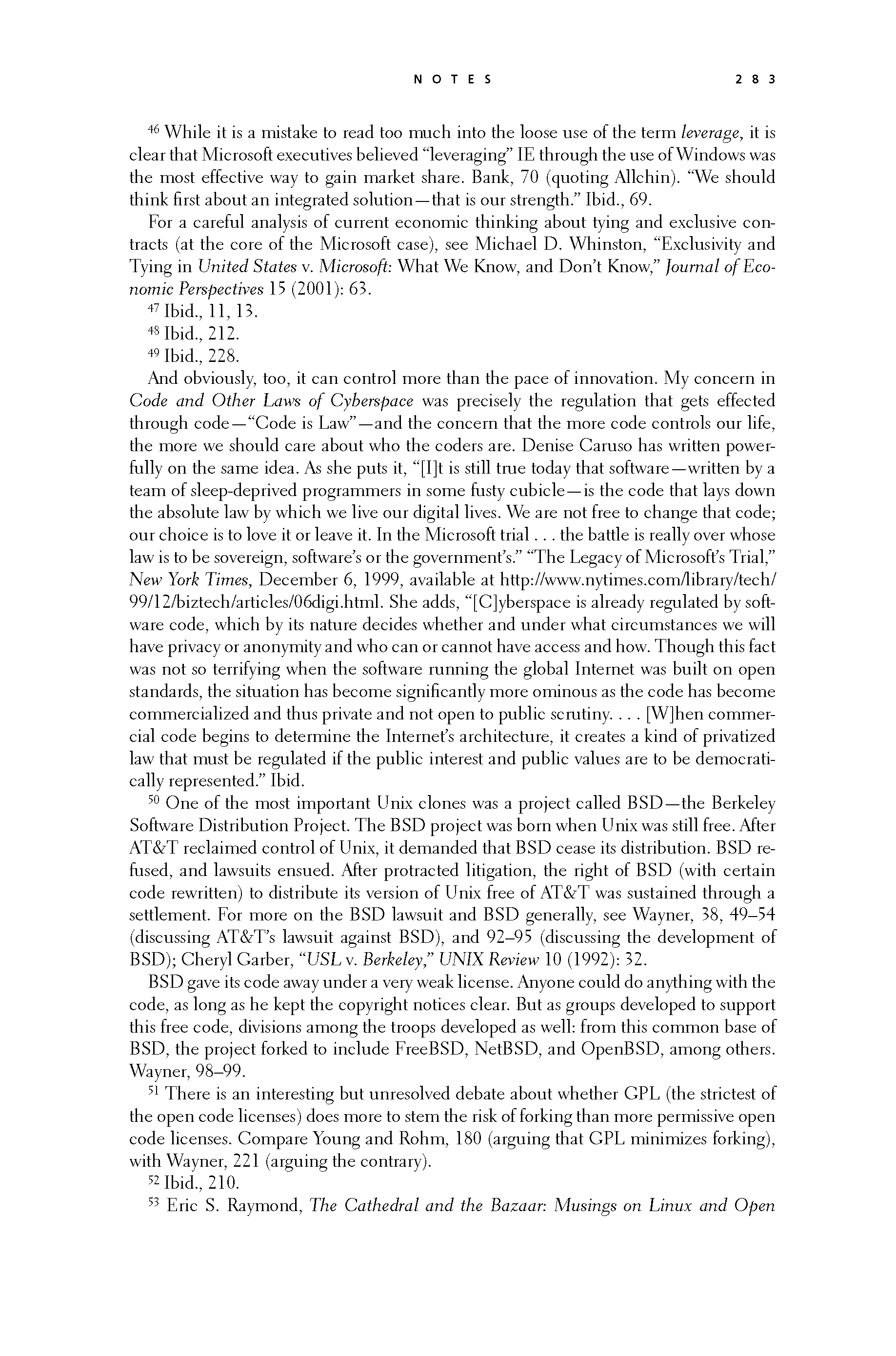 p282 _
-chap- _
toc-1 _
p283w _
toc-2 _
+chap+ _
p284
p282 _
-chap- _
toc-1 _
p283w _
toc-2 _
+chap+ _
p284
[4-46] While it is a mistake to read too much into the loose use of the term _leverage,_ it is
clear that Microsoft executives believed "leveraging" IE through the use of Windows was
the most effective way to gain market share. Bank, 70 (quoting Allchin). "We should
think first about an integrated solution -- that is our strength." Ibid., 69.
For a careful analysis of current economic thinking about tying and exclusive con-
tracts (at the core of the Microsoft case), see Michael D. Whinston, "Exclusivity and
Tying in _United_States_ v. _Microsoft:_ What We Know, and Don't Know," _Journal_of_Eco-_
_nomic_Perspectives_ 15 (2001): 63.
[4-47] Ibid., 11, 13.
[4-48] Ibid., 212.
[4-49] Ibid., 228.
And obviously, too, it can control more than the pace of innovation. My concern in
_Code_and_Other_Laws_of_Cyberspace_ was precisely the regulation that gets effected
through code -- "Code is Law" -- and the concern that the more code controls our life,
the more we should care about who the coders are. Denise Caruso has written power-
fully on the same idea. As she puts it, "[I]t is still true today that software -- written by a
team of sleep-deprived programmers in some fusty cubicle -- is the code that lays down
the absolute law by which we live our digital lives. We are not free to change that code;
our choice is to love it or leave it. In the Microsoft trial... the battle is really over whose
law is to be sovereign, software's or the government's." "The Legacy of Microsoft's Trial,"
_New_York_Times,_ December 6, 1999, available at http://www.nytimes.com/library/tech/
99/12/biztech/articles/06digi.html. She adds, "[C]yberspace is already regulated by soft-
ware code, which by its nature decides whether and under what circumstances we will
have privacy or anonymity and who can or cannot have access and how. Though this fact
was not so terrifying when the software running the global Internet was built on open
standards, the situation has become significantly more ominous as the code has become
commercialized and thus private and not open to public scrutiny... [W]hen commer-
cial code begins to determine the Internet's architecture, it creates a kind of privatized
law that must be regulated if the public interest and public values are to be democrati-
cally represented." Ibid.
[4-50] One of the most important Unix clones was a project called BSD -- the Berkeley
Software Distribution Project. The BSD project was born when Unix was still free. After
AT&T reclaimed control of Unix, it demanded that BSD cease its distribution. BSD re-
fused, and lawsuits ensued. After protracted litigation, the right of BSD (with certain
code rewritten) to distribute its version of Unix free of AT&T was sustained through a
settlement. For more on the BSD lawsuit and BSD generally, see Wayner, 38, 49-54
(discussing AT&T's lawsuit against BSD), and 92-95 (discussing the development of
BSD); Cheryl Garber, _"USL_ v. _Berkeley,"_UNIX_Review_ 10 (1992): 32.
BSD gave its code away under a very weak license. Anyone could do anything with the
code, as long as he kept the copyright notices clear. But as groups developed to support
this free code, divisions among the troops developed as well: from this common base of
BSD, the project forked to include FreeBSD, NetBSD, and OpenBSD, among others.
Wayner, 98-99.
[4-51] There is an interesting but unresolved debate about whether GPL (the strictest of
the open code licenses) does more to stem the risk of forking than more permissive open
code licenses. Compare Young and Rohm, 180 (arguing that GPL minimizes forking),
with Wayner, 221 (arguing the contrary).
[4-52] Ibid., 210.
[4-53] Eric S. Raymond, _The_Cathedral_and_the_Bazaar:_Musings_on_Linux_and_Open_
[[283]]
p282 _
-chap- _
toc-1 _
p283w _
toc-2 _
+chap+ _
p284